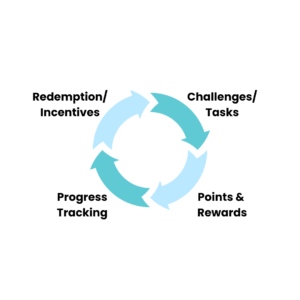In today’s crowded digital landscape, capturing and maintaining user attention is increasingly challenging. One effective strategy to boost engagement and user experience is gamification—the use of game mechanics like points, rewards, and challenges in non-game contexts such as marketing. By tapping into human psychology, gamification enhances customer interaction and fosters brand loyalty.
What is Gamification?
Gamification integrates game-like elements into marketing to motivate users through competition, achievement, and rewards. These elements—such as earning points, badges, or progressing through levels—capitalize on psychological drivers like achievement, social validation, and curiosity, making users more likely to engage with the brand repeatedly.
The Psychological Appeal
- Achievement & Rewards:
Users are motivated by the sense of accomplishment that comes from earning points or unlocking rewards.
- Social Validation:
Leaderboards and social sharing options foster healthy competition and external recognition.
- Curiosity & Exploration:
Gamification encourages users to explore and interact more with the brand.
- Instant Gratification:
Immediate rewards and feedback create a sense of satisfaction, driving further engagement.
Benefits of Gamification in Marketing
- Increased User Interaction:
By adding a layer of interactivity, gamification keeps users engaged for longer periods.
- Enhanced Customer Loyalty:
Loyalty programs that reward users for continued engagement help build long-term relationships.
- Better Data Insights:
User engagement with gamified content provides valuable data for tailoring future marketing efforts.
- Boosted Brand Awareness:
Gamified experiences, especially with social sharing, expand brand visibility.
- Higher Conversion Rates:
Gamification encourages users to complete actions, increasing the likelihood of conversions.
The Gamification Process
Here’s a simple breakdown of the gamification process:

This cycle encourages continual interaction, rewarding users at each step, which motivates them to stay engaged with the brand.
Examples of Gamification
- Starbucks Rewards:
Customers earn stars for purchases, unlocking rewards and exclusive offers.
- Nike+Run Club:
Users track their runs, earn badges, and compete on leaderboards, building a stronger connection with the brand.
- Duolingo:
The app motivates users with streaks, levels, and badges, making language learning enjoyable and addictive.
Gamification is a powerful marketing tool that leverages psychological principles to engage users, enhance their experience, and foster loyalty. By incorporating rewards, challenges, and social validation, brands can create memorable, interactive experiences that keep customers coming back.
SOURCES:
Hamari, J., Koivisto, J., & Sarsa, H. (2014). Does gamification work? A literature review of empirical studies on gamification. 47th Hawaii International Conference on System Sciences (pp. 3025–3034). IEEE. https://doi.org/10.1109/HICSS.2014.377
Seaborn, K., & Fels, D. I. (2015). Gamification in theory and action: A survey. International Journal of Human-Computer Studies, 74, 14-31. https://doi.org/10.1016/j.ijhcs.2014.09.006